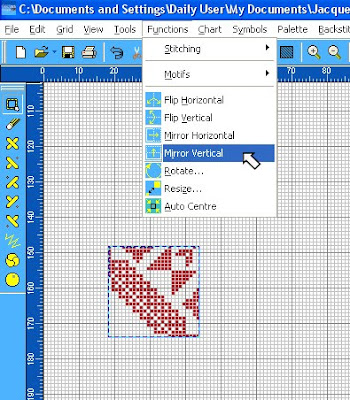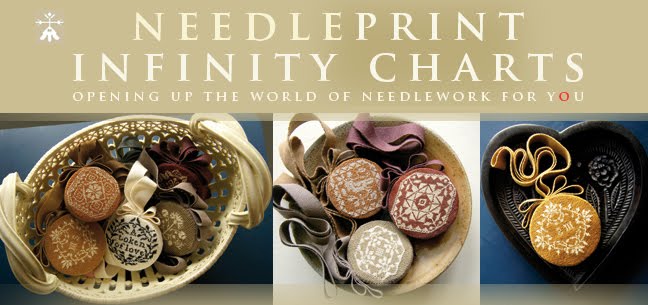
There are so many possibilities for medallion design as you have seen from the Ackworth samplers. When I first carried out the research on the medallions, I charted everything. The aim of the research was to see if there were certain Ur-Motifs or fundamental motifs from which others had been copied. If this were true then we might be able to put forward the hypothesis that some samplers were 'model' or 'teaching' samplers and that the other girls had recourse to these as pattern books for working the medallions on their own samplers. What I did find out was that, with the sample we had, no medallions appeared to have been copied from a single source. In fact, all the medallion patterns differed slightly from sampler to sampler. Some had slightly different borders, others minor adaptions. The girls were doing exactly what you do, making slight personal changes...or mistakes which they worked into the overall design with a certain aplomb!
Which means you are free to customise your medallions, or design new ones. And the wonderful thing is, you only have to design a quarter of the medallion and then let the software do the rest for you. The important thing always to remember is to ensure that the central horizontal and vertical lines of the design are included. Think of these as pivot points for your design. First create a quadrant - the bottom left hand quadrant is a good place to start - but don't worry if you prefer to start work with a different quadrant in your design, I'll discuss later what is to be done if this is the case (as it is for me!), but for now just grasp the concept by its tail.

Once you have this quadrant, closely lasso it, (by that I mean make sure there is no border of blank cells anywhere on the graph that you enclose).
Next choose Functions from the top tool bar and select Mirror Vertical.

Now you have two quadrants - plus a mirrored central horizontal axis. It is quite simple to remove this duplicated pattern line simply by grabbing the bottom quadrant and moving it one square up. You can appreciate that it is far easier to take out this line, than to have to fill it in later and that is why it is always important to include these central lines in your design at the start.

So now you have half a medallion, all you need to do is lasso it closely and choose Functions from the top tool bar and this time select Mirror Horizontal from the drop down menu.

Now you have a whole medallion - plus a duplicated central pattern line and you know how to remove that now, don't you? Simply move the left hand half of the design horizontally one square to the right.

OK, so what happens if you are awkward like me and you only seem able to design top left hand quadrants and can't seem to get into the habit of designing bottom left hand quadrants? Stay as sweet as you are, is my motto.

Design the top left hand quadrant and when you are done, lasso it closely and choose Flip Vertical from the drop down Functions menu and there you are, right where you need to be to generate the other quadrants of your medallion with ease and speed.



















Oh this is so much fun! It's amazing how different one quadrant looks when made up into a whole medallion.
ReplyDeleteI have quite a few patterns stored now, I just need more time to stitch them.
Wonderfully clear instructions as ever, thank you Jacqueline.